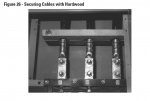Lashing at 10kA
Lashing at 10kA
Most of the literature I have seen talks about lashing for fault currents in excess of 65kA.
Page 29 of this one, has a chart showing that different fault currents and different devices have different results.
http://static.schneider-electric.us...ow Voltage Switchgear/PZ4/80298-002-06_en.pdf
I just received an email from an engineer at Eaton:
Our minimum requirements for cable lashing can be found on page 9 of the attached installation manual. This lashing applies to anything over 10kA.
In addition, per NEC Code 230.51(A), service entrance conductors must be “strapped” within 12” of every service head, gooseneck or enclosure connection, and again at intervals of no more than 30” past this first 12” strap. They do not define what “strapping” is so we follow the guideline set in the attached manual.
END ENGINEER QUOTE
Within the pdf he sent me, the dialogue begins with:
Cable bracing instructions
For short-circuit ratings above 10,000A rms, install cable braces
per the following instructions:
END PDF COPY/PASTE
So...it is interesting at least, all the way down to >10000 rms.
The Siemens lashing started at 65kA and went up through 200kA, each diagram as a different style, same size and type of rope, a 3/8" nylon. The Eaton is a tad different:
The material required for the cable braces is 3/8”diameter
nylon rope (note1) or any rope having a minimum tensile strength
of 2,000 pounds (note 2) .
END CITATION
The two notes are manufacturers:
(note 1) Wellington Puritan Mills, Inc., Madison, GA, Catalog Number 10989.
(note 2) Norva Products, Carrolton, GA, Catalog Number TPR12.




